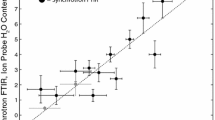Abstract
THE melting temperatures of minerals in the Mg–Fe–Si–O-system play a fundamental role in the chemical differentiation, rheology and geodynamics of the Earth's lower mantle. We have previously shown1 that the melting curve of (Mg, Fe)SiO3-perovskite—the dominant mineral in the lower mantle—is extremely steep, implying melting temperatures at the bottom of the lower mantle in excess of 7,000 K. The large difference between actual mantle temperatures and the melting temperature inferred from our experiments suggests that the viscosity of the lower mantle is much larger than that typically used in convection models2. Theoretical estimates of the melting temperature of MgO (refs 3–5) suggest even higher melting temperatures for (Mg, Fe)O-magnesiowiistite, the second most abundant mineral in the lower mantle. We show here, however, that the melting curves of these two minerals are flat compared to the perovskite melting curve, thus lowering the upper bounds for the solidus in the lowermost mantle to about 5,000 K. This reduces the estimate of the viscosity to more realistic levels but still rules out large-scale melting in the lower mantle. Because magnesiowiistite is slightly more dense than Mg–Fe–Si-perovskite due to iron partitioning, chemical segregation in the lower mantle cannot be excluded in regions where the local temperature exceeds the solidus.
Similar content being viewed by others
References
Zerr, A. & Boehler, R. Science 262, 553–555 (1993).
van Keken, P. E., Yuen, D. A. & van den Berg, A. P. Science 264, 1437–1439 (1994).
Gong, Z., Cohen, R. E. & Boyer, L. L. A. Rep. Director Geophys. Lab. 1990–1991 129–134 (Carnegie Instn. Wash., Washington DC, 1991).
Jackson, I. Phys. Earth. planet. Inter. 14, 86–94 (1977).
Ohtani, E. Phys. Earth. planet. Inter. 33, 12–25 (1983).
Ito, E. & Katsura, T. in High-Pressure Research: Application to Earth and Planetary Sciences (eds Syono, Y. & Manghnani, M. H.) 315–322 (Terrapub, Tokyo/American Geophysical Union, Washington DC, 1992).
Kondo, K., Ahrens, T. J. & Sawaoka, A. J. appl. Phys. 54, 4382–4385 (1983).
Schmitt, D. R. & Ahrens, T. J. J. geophys. Res. 94, 5851–5871 (1989).
Boehler, R. Nature 363, 534–536 (1993).
Riley, B. Revue int. Hautes Temp. Refract. 3, 327–336 (1966).
Lindemann, F. A. Phys. Z. 11, 609–612 (1910).
Boehler, R. & Ramakrishnan, J. J. geophys. Res. 85, 6996–7002 (1980).
Kraut, E. A. & Kennedy, G. C. Phys. Rev. Lett. 16, 608–609 (1966).
Kesson, S. E. & FitzGerald, J. D. Earth planet. Sci. Lett. 111, 229–240 (1992).
Boehler, R. Earth planet. Sci. Lett. 111, 217–227 (1992).
Weertmann, J. & Weertmann, J. R. A. Rev. Earth planet. Sci. 3, 293–315 (1975).
Chopelas, A. & Boehler, R. Geophys. Res. Lett. 19, 1983–1986 (1992).
Author information
Authors and Affiliations
Rights and permissions
About this article
Cite this article
Zerr, A., Boehler, R. Constraints on the melting temperature of the lower mantle from high-pressure experiments on MgO and magnesioüstite. Nature 371, 506–508 (1994). https://doi.org/10.1038/371506a0
Received:
Accepted:
Issue Date:
DOI: https://doi.org/10.1038/371506a0
- Springer Nature Limited
This article is cited by
-
Wettability behavior, photoluminescence and optical properties studies of nanostructured vanadium-doped magnesium oxide thin films: an effect of V concentrations
Optical and Quantum Electronics (2023)
-
Characterization of MgO thin film prepared by spray pyrolysis technique using perfume atomizer
Journal of Materials Science: Materials in Electronics (2020)
-
Melting phase relations in the MgSiO3–CaSiO3 system at 24 GPa
Progress in Earth and Planetary Science (2017)
-
Compositionally-distinct ultra-low velocity zones on Earth’s core-mantle boundary
Nature Communications (2017)
-
Melting temperatures of MgO under high pressure by micro-texture analysis
Nature Communications (2017)





